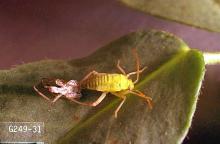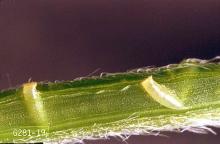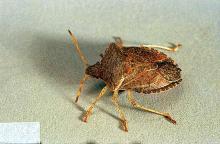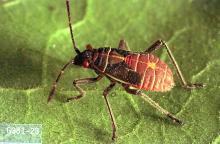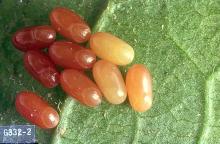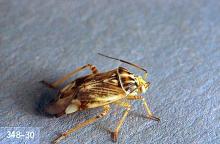Family Miridae, including
Lygus bug (Lygus spp.)
Western tarnished plant bug (Lygus hesperus)
Pest description and crop damage This group of insects have piercing-sucking mouthparts and a triangle between the head and the wings. Feeding on fruit causes depressions and hard corky areas. Lygus bug adults are 0.25 inch in length, green to brown.
Biology and life history These insects overwinter as adults and may migrate into orchards around bloom. Lygus bugs are especially problematic near alfalfa fields. Lygus bugs have a wide host range and will feed on many broadleaf weeds. As broadleaf weeds around orchards dry up during the summer, Lygus bugs may migrate into the orchard and feed on the fruit.
Pest monitoring Monitoring by limb tapping can aid in detection. A sweepnet can be used to sample the groundcover to determine if Lygus bugs are present. Damage to fruit is often the first indication of their presence in the orchard.
Management-cultural control
Establishment and maintenance of a weed-free orchard groundcover will deter Lygus bugs. A sod groundcover that is mowed regularly will minimize Lygus bug activity within the orchard. Eliminate border habitat or target management on border rows. Hand-thin damaged fruit.
Management-chemical control: HOME USE
- azadirachtin (neem extract)-Products containing neem extract may be phytotoxic to some pear cultivars. Some formulations are OMRI-listed for organic use.
- bifenthrin-Highly toxic to bees.
- carbaryl-Highly toxic to bees.
- gamma-cyhalothrin-Highly toxic to bees.
- kaolin clay-Applied as a spray to leaves, stems, and fruit, it acts as a repellant to some insect pests. Some formulations are OMRI-listed for organic use.
- malathion-Highly toxic to bees.
- permethrin-Highly toxic to bees.
- pyrethrins-Highly toxic to bees. Some formulations are OMRI-listed for organic use.
- zeta-cypermethrin-Highly toxic to bees.
Management-chemical control: COMMERCIAL USE
- bifenthrin (Brigade 2EC) at 2.6 to 12.8 fl oz/A. REI 12 hr. PHI 14 days. Do not exceed 32 fl oz/A per season. Use of pyrethroid insecticides during the growing season can disrupt naturally occurring biological control and may result in increased populations of some pests.
- clothianidin (Belay) at 4 to 6 fl oz/A. REI 12 hr. PHI 7 days. Do not exceed 12 fl oz/A per season. Repeated use may induce spider mite buildup.
- diazinon (Diazinon 50WP) at 1 lb/100 gal (100 gallon minimum) plus 2 to 3 gal dormant oil or 1 to 1.5 gal superior type oil per 100 gal water. REI 4 days. PHI 21 days. Closed cab required. Apply as a dormant spray. When using spray oils, follow spray oil manufacturer's use directions. Do not apply more than 4 lb of product or 6 gal of oil per acre. Apply only once during the dormant season.
- fenpropathrin (Danitol 2.4EC) at 16 to 21 fl oz/A. REI 1 day. PHI 14 days.
- flonicamid (Beleaf 50SG) at 2 to 2.8 oz/A. REI 12 hr. PHI 21 days. Do not exceed three applications per season.

